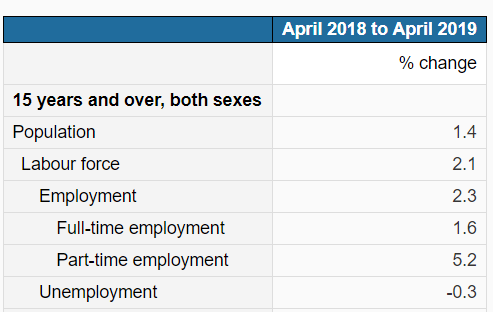The Canadian Job Market Is Far From Robust
The Canadian labor market displays all the characteristics of a market in dynamic change as full-time work gives way to the rise of part-timers--- the ‘gig’ economy seems to be in full force in Canada. Today Statistics Canada released its jobs report for April. The opening line to the press release captures the issue in a nutshell. “Employment rose by 107,000 in April, with notable gains in part-time work for youth”. The headline number seems very impressive-----a continuation of job creation that has been relatively solid, especially in an environment featuring headwinds such as weak oil prices, U.S. trade restrictions and a global slowdown in trade. But how good are these jobs? One clue can be found in the split between full-time and part-time work.
As the accompanying table reveals, over the past year, the growth in jobs have been dominated by part-time employment which has grown 5.2% annually. Full-time work grew by a mere 1.6%, barely keeping pace with the growth in output. Over 40% of all the new jobs created were part-time work over the past 12 months.
(Click on image to enlarge)

The choice between full- and part-time work depends on personal preferences and other priorities such as caring for children and attending school. We can attribute to the high rate of part-time work for those 15-24 years who decide to attend school or experimenting with different types of work in an effort to find a career path. We expect that type of labor market activity for that age bracket.
However, there is a significant number of part-time workers who would prefer full-time work but are unable to land full-time jobs due to current economic conditions. Again, the data provides some clue to the nature of part-time vs. full-time work.
Let’s look at the all-important category of men and women 25 years and older. Men working at part-time jobs grew at a very fast pace of 11.2% over the past 12 months; whereas, women’s part-time work increased by just 2.6%. The slower growth in women working part-time can be attributed to many women opting out of the labor market to care for children. The rise in male part-time employment, however, may be explained, in large measure, by poor economic conditions---- these workers may wish to have full-time work, but are unable to find any.
In 2017, nearly one in five employed Canadians, or 3.5 million people, were working part-time (less than 30 hours per week) in their main or only job. Some do so by choice, others have no choice but to accept this form of underemployment. More importantly, the shift in favor of part-time work is one contributing factor to why Canadian productivity growth has fallen behind in recent years.



